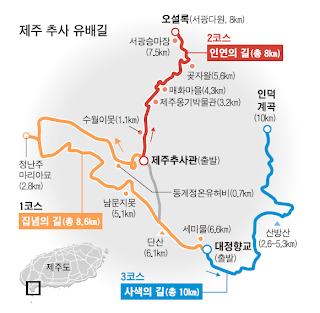Jeju Island, Korea (May 6, 2013)
Jeju Island, well-known scenic spot of Korea, is also a place having memories of Chusa(Kim Jeonghee 1786-1856)
Chusa was a Confucian scholar and artist of the Joseon Dynasty.
He was a member of royal family, and was bright since he was a child.
He could also travel Qing China as the dependant of diplomat when he was young.
this experience had influenced throughout his life and his art work.
but he was exiled to Jeju island far away from Seoul by false charges at his 55.
Recently, Jeju established the historical road follwing the life of Chusa, named "Chusa Yubaekil(추사 유배길)"
Chusa Yubaekil is consist of three roads;
the Road of Meditation(사색의 길)
the Road of Connection(인연의 길)
the Road of Tenacity(집념의 길)
#. The Road of Meditation
The Road of Meditation starts at Andeok Valley and reaches to Sanbangsan Mountain.
Andeok Valley is very interesting to me because valleys are rarely found in Jeju Island.
▲ A shelter prehistoric in which inhabitants had lived
the valley is not that long to look around but it has primitive nature intact
I could enjoy feelings as if the time stand still
I would like to strongly recommend the Andeok Valley for the experience of nature's wonder
even though it had a bad transportation
After looking around the valley, I tried to go to Mt.Sanbangsan on foot
but I gave up since there were just few direction boards to the mountain,
and the road was no longer fascinating to me as the Andeok Valley ended
so I took a bus directly bound for Mt.Sanbangsan
# Mt.Sanbangsan
Mt.Sanbang is 395m in height not that high
but its unique appearance attracts visitors' attentions.
In fact, it has an interesting legend related to its unique appearance.
Jeju island, a volcanic island, has Mt.Halla with a huge crater in the center.
the legend says that Mt.Sanbangsan was the top of the Mt.Halla.
Sanbanggulsa Grotto
there is a Buddha statue made of stone.
detail-oriented visitors can find several poems and letters on the wall, which are presenting its long history.
the grotto has also an intriguing legend, which says that
water drops falling out from the ceiling of the cave is the tear drops of gaddess named Sanbangdeok
visitors can taste the water
# Daejeong Confucian School
Daejeong Confucian School is the starting point of the Road of Tenacity
Jeju had not been much influenced by Confucianism as much as the mainland of the mainland
So visiting there also gave me a different pleasure
# Daejeong Village
Daejeong Village is an old village with lots of historical sites and heritage
In the Joseon period, there was a goverment office ruling the western area of Jeju
Dol Harubang, man-shaped stone statue, is the symbol of Jeju
especially, Dol Harubangs of Daejeong Village are believed to be the oldest ones
# Mrs.Jeong Nanjoo Maria's grave
Jeong Nanjoo was a daughter of Jeong yakhyeon who was an older brother of Jeong yakyong.
the Jeongs was an intellectual family of the late Joseon Dynasty, but they were repressed by the king's maternal relatives, for being catholic converts.
Jeong Nanjoo Maria was exiled to Jeju in the wake of the execution of her husband, Hwang Sayeong, who was another convert.
While heading to Jeju from Seoul, she left her baby boy at Chuja Island
since she was afraid that her boy would be harmed.
the descendants of the baby boy are told to be still living in the island
Jeong Maria was the first Catholic convert who lived in Jeju.
Korean Catholic currently preserves this area as a holy place.
after looking around the maria's grave located outside of Daejeong village,
I rode a bicycle back to the village
On the way to the village, I ran into a group of monuments of old people.
I would like to introduce one of the stories written on them.
on wedding day, bride lost her husband by a fall from a horse.
but she had never left the family of the husband, for her whole life, looked after parents in law.
#. Chusa Memorial Museum
Chusa is Kim Jeonghee's pen name who represents the 19th century of Korea.
He made a great contribution in the Confucian arts including calligraphy as well as the research of ancient Korean epigraphs.
this museum was built on the site where Chusa lived for about nine years since he had been sent into exile on Jeju.
In this place, he accomplished his own calligraphy, Chusache, and also produced the legendary painting, Sehando.













댓글 없음:
댓글 쓰기